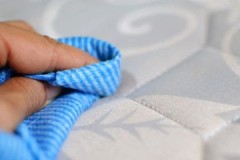Rules and tips on how to wash a blanket to keep it soft and fluffy
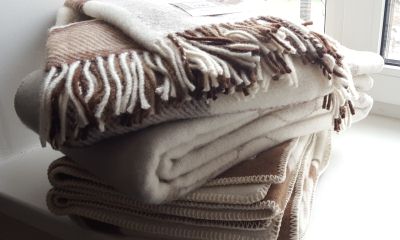 For three centuries, the blanket has served a person, creates coziness and comfort. They can be used to make the bed to protect them from dust and the paws of the ubiquitous pets. You can wrap yourself in it and drink a cup of aromatic tea.
For three centuries, the blanket has served a person, creates coziness and comfort. They can be used to make the bed to protect them from dust and the paws of the ubiquitous pets. You can wrap yourself in it and drink a cup of aromatic tea.
Everyday use leaves traces on the product, which can only be removed by water-heat treatment (WTO) It must be carried out in accordance with the recommendations of the manufacturer and professionals.
How to properly wash a blanket (at what temperature, on what program, mode) so that it remains soft and fluffy, we will tell in the article.
Content
Preparatory stage
So that the blanket does not lose its original appearance and softness, Before washing, you need to pay attention to several points:
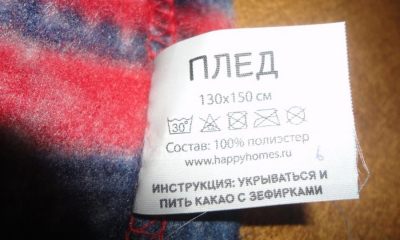 Information about the composition and marking on the label will tell you which type of washing is preferable for this product.
Information about the composition and marking on the label will tell you which type of washing is preferable for this product.- A large-sized blanket, regardless of the material, will have to be washed by hand.
- An assessment of the degree of contamination will help you choose a gentle cleaning method.
- Correctly selected detergents will prolong the life of your favorite item.
Information on the label
Labels on blankets - comprehensive information about the composition and care, which will help to increase the service life.
Standard for graphic images and their interpretation:
- Wash. The washing method determines the image of the basin with water, the numbers indicate the maximum permissible temperature.
- Whitening and dry cleaning... Tips for housewives and professionals to help clean blankets without compromising on fibers and color.
- Spin, drying... Recommendations will help to avoid deformation of the product.
- Ironing... The crossed out iron on the label means that the fibers of the product may melt when exposed to high temperatures.
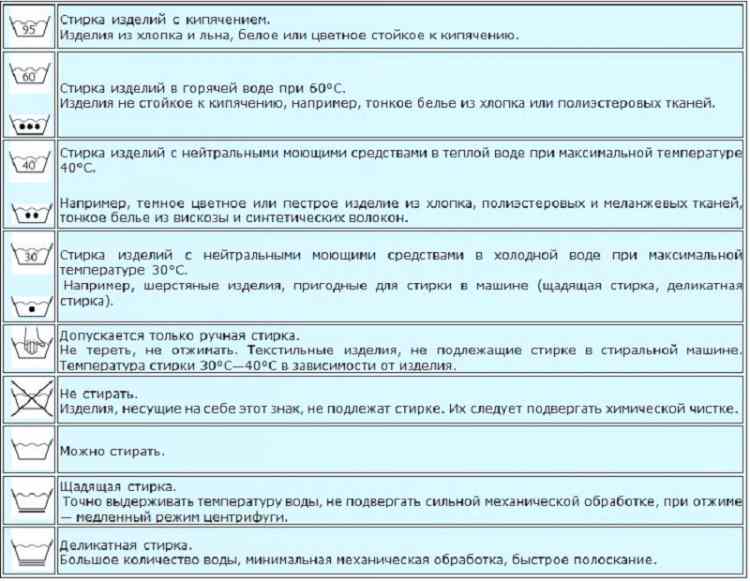
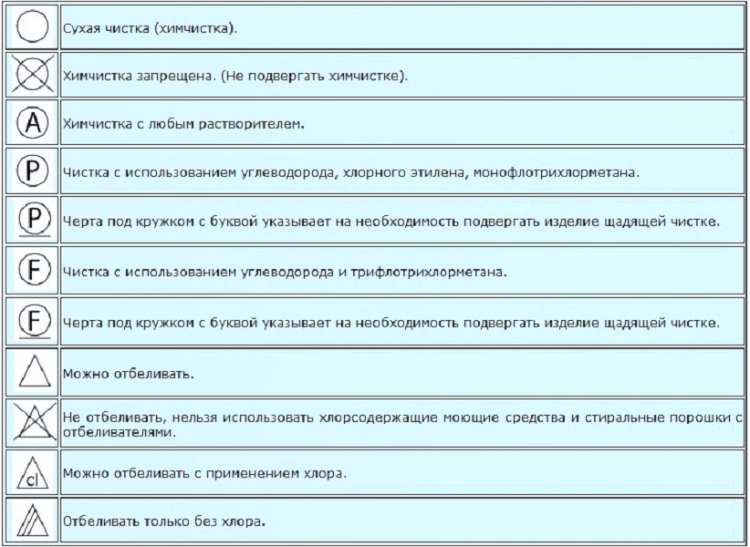

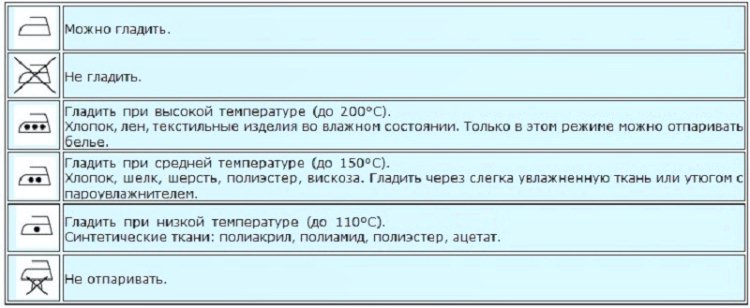
In addition to recommendations for care, the label contains information about the composition, which will help you choose the optimal mode for machine washing, if it is acceptable.
If the label on the product interferes with operation, it can be removed, but be sure to keep... Its absence can be a refusal for washing a plaid in dry cleaning.
Types of washing
The choice of cleaning method for each blanket is individual, but there are general recommendations. They can be adhered to if the product label is lost.
In a washing machine
The easiest way to wash a blanket is entrust it to an automatic machine with a capacity of at least 4.5 kg... Most synthetic fabrics and some natural ones tolerate such a procedure well if the regime is chosen correctly.
The main condition is that the volume of the loaded product should not occupy more than ¾ of the drum, otherwise it will not extend. The absorbed moisture increases the weight of the blanket, which can lead to an imbalance in the drum and damage to an expensive assistant.
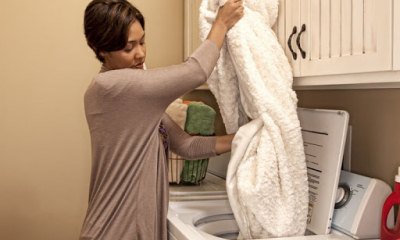 Step-by-step instruction:
Step-by-step instruction:
- Load the product into the drum. It is recommended to carefully roll up a large blanket into a ball, evenly distributing it along the walls.
- Select the mode in accordance with the composition, adjust the temperature and spin, referring to the prompts in the label.
- Pour liquid detergent and fabric softener into the special compartments and start the program.
For some fabrics, spinning is contraindicated, in this case it is better to refuse it or choose the minimum number of revolutions.
The video will tell you how to wash a blanket in a washing machine:
Can it be hand washed?
Hand washing a small product is not difficult. This requires:
- fill the container with warm water, the temperature should not be higher than 30 degrees;
- add liquid detergent, stir;
- lower the blanket, let it get wet and leave for 2 hours, for woolen ones, 10-15 minutes is enough;
- stroking the product over the entire surface;
- move the blanket away from the drain, open it so that all the liquid is gone;
- collect water again and repeat several times until all the soap solution is gone from the fibers;
- drain the water and let the product drain, you can use the grate for this.
Dry cleaning at home
Products from natural wool valuable breeds of animals do not tolerate the effects of water, as well as natural fur... Dry cleaning is preferable for them, which can be done at home using a soft brush and soapy water.
Step-by-step instruction:
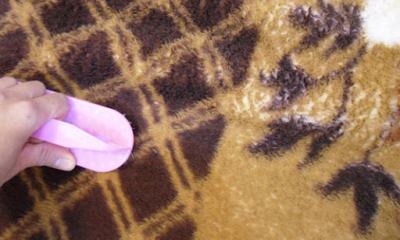 Shake the product to remove dust.
Shake the product to remove dust.- Spread out on a flat, hard surface.
- Detergent for washing wool (it can be replaced with shampoo for hair or pets) diluted with water, mix.
- Dip the brush in the resulting liquid and gently process the surface of the blanket on both sides.
- Dry the product by providing fresh air.
- Vacuum up (it is better to use a model for cleaning the car).
You can add 1 teaspoon of vinegar to the liquid (9% solution, the essence will not work). It will give the fibers a shine and softness.
Dry cleaning
Professional help is expensive, but sometimes you can't do without it... Especially when it comes to luxury items that are easy to spoil.
How to keep soft?
To keep the garment soft, you need to choose the right detergent. Concentrated gels and special shampoos combined with conditioners are ideal. They contain enzymes that can deal with dirt at low temperatures without damaging the fiber structure.
Treatment agent
Suitable for washing blankets with different compositions:
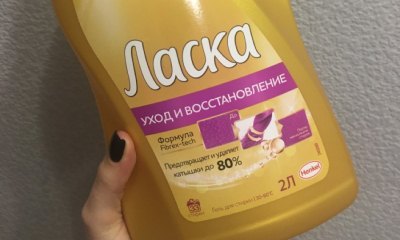 Concentrate for washing Laska "Care and restoration" provides gentle cleansing and prevents the formation of pellets, gives softness without using a conditioner. Weasel “Wool and Silk” is suitable for delicate fabrics. Price from 180 to 250 rubles per 1 liter.
Concentrate for washing Laska "Care and restoration" provides gentle cleansing and prevents the formation of pellets, gives softness without using a conditioner. Weasel “Wool and Silk” is suitable for delicate fabrics. Price from 180 to 250 rubles per 1 liter.- Sinergetic Organic Laundry Gel removes impurities at a temperature of 20-60 degrees, cares for fibers. Suitable for delicate fabrics and baby clothes. The price is 320-350 rubles for 1 liter.
- Gel concentrate Meine Liebe designed for hand and machine wash of delicate fabrics. Protects against the formation of pellets, cares for natural fibers, is effective in combating dirt. Price from 280 to 330 rubles for 800 ml.
Air conditioning
Fabric softeners perform several functions:
- soften the fabric;
- remove static electricity;
- make ironing easier or unnecessary.
Process features for products from different materials
The choice of washing method directly depends on the composition. Blankets made of synthetic fibers are less capricious to care for and tolerate washing well in a washing machine. The natural composition requires special care and attention.
Synthetic
Products made of artificial fibers are light, soft, but capable of accumulating static electricity... Consequently, dust accumulates faster.
All the nuances of WTO synthetic blankets are collected in the table:
| Material | Features: | Washing type | Mode | Temperature | Spinning | Drying |
| Acrylic and polyester | Soft, lightweight, durable. Unpretentious care. Pills are formed, absorb odors | Machine room | Delicate, synthetic | 20-30 degrees | Maximum | In an upright position, avoid exposure to ultraviolet rays |
| Microfiber | Wear-resistant, easy to clean, dry quickly. Ironing and drying at high temperatures is not allowed | Machine, manual | Delicate, synthetic | 40-60 degrees | No spin or 400 revolutions | Large product only on a horizontal surface, avoiding sunlight |
| Faux fur, plush | Hardwearing, easy to clean. Dust accumulates quickly, heavy | Machine room | Delicate or synthetic | 30-40 degrees | 400 rpm | On a horizontal surface |
| Fleece | Lightweight, resistant to mechanical stress, does not require ironing. Sensitive to high temperatures | Machine, manual | Delicate, handcrafted or synthetic | 40 degrees | No spin or 400 revolutions | Upright in the shade |
| Viscose | Unpretentious care. Requires conditioner to soften | Machine room | Delicate | 40-60 degrees | Maximum | Upright |
Natural
Natural fibers are less prone to pollution, hypoallergenic, but afraid of high temperatures, mechanical impact. The service life of products with such a composition, despite the high price, is limited.
To keep a natural fiber blanket in its original form longer, you must take into account the recommendations of professionals:
| Material | Features: | Washing type | Mode | Temperature | Spinning |
| Woolen | Resistant to dirt. Are prone to deformation with changes in water temperature and high rates | Dry cleaning, manual, machine (in extreme cases) | Wool or delicate | 30 degrees (for washing and rinsing) | Without it, do not twist when hand wash |
| Cotton | Dry for a long time, wrinkle easily, can “shrink” under the influence of high temperatures | Machine, manual | Cotton | Up to 60 degrees | Maximum |
| Bamboo | Soft, lightweight. Do not tolerate exposure to UV radiation and drying in a suspended state | Machine, manual | Delicate in a special bag | 30 degrees | No spin or 400 revolutions |
| Silk | Delicate, light. Poorly tolerate mechanical stress. | Manual, machine | Silk | 30 degrees | No mechanical impact |
| Cashmere | Soft, gentle, capricious in care | Manual, dry cleaning, rarely machine | Cashmere | Up to 40 degrees | No mechanical impact |
Drying blankets with a natural composition is recommended to be carried out in a horizontal position.Products that have mixed fibers are subject to WTO according to the rules of the component, the percentage of which prevails.
Handmade
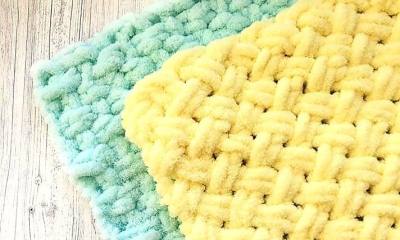 A special category that requires careful care... Crocheted synthetic and blended blankets can be machine washed on the delicate cycle and dried on the rope.
A special category that requires careful care... Crocheted synthetic and blended blankets can be machine washed on the delicate cycle and dried on the rope.
The cloth made using this technique retains its shape well after washing at a temperature of 30-40 degrees.
The product, knitted with needles, lends itself to deformation... It is necessary to dry it only unfolded, and in the case of a cotton composition, also steam it with an iron.
Large and voluminous
Washing a large, voluminous blanket is a difficult task for a fragile woman, so an assistant with physical strength is definitely needed.
In a private house, you can wash a large product in a way that is used for carpets... It is necessary:
- Hang a blanket on the street.
- Prepare a soapy solution.
- Apply liquid with a brush, paying attention to the most contaminated areas.
- Rinse thoroughly with clean water using a hose.
- Dry out of direct sunlight.
If none of the methods is suitable, there is only one way out - professional dry cleaning.
The video will tell you how to clean a large blanket:
Do I need to wash after purchase?
There is no definite answer, each hostess makes a decision independently. It is important to consider:
 Blankets are produced at large enterprises using equipment that is not sterile. Plus the hands of employees without gloves.
Blankets are produced at large enterprises using equipment that is not sterile. Plus the hands of employees without gloves.- Consumables are stored in warehouses, first at the manufacturer, then at the factory, often transported without packaging.
- In stores, customers choose products by touch to make sure they are soft. As a result, dust accumulates and pollution of various natures appears.
If the package has not been opened, has no obvious traces of contamination, then the blanket should be ventilated enough to get rid of the “factory” smell. Otherwise, you will have to wash it.
It is imperative to wash baby blankets after purchase., they will come into contact with the delicate skin of the baby. You need to use only special products that do not contain aggressive substances and fragrances.
How to dry?
Drying a blanket is an important stage. If you do not follow the rules, the product can not only lose its softness and attractiveness, but also become unusable as a result of deformation.
5 main "not":
 dry in an upright position, with the exception of some synthetic blankets;
dry in an upright position, with the exception of some synthetic blankets;- use the drying mode in the washing machine;
- expose the product to direct exposure to ultraviolet rays;
- dry near heating and heating devices;
- use a hairdryer for these purposes.
If the blanket is not completely dry, you cannot roll up and pack it. This will lead to mold, which is difficult to remove.
Products with long pile or a weed blanket are shaken well before drying so that the fibers take their natural position. A dry piece of furniture can be combed first with a comb with large teeth, then with a soft brush, being careful.
Care and storage recommendations
Recommendations of experienced housewives:
- To prevent the accumulation of dust during storage, the product must be wrapped in an old cotton pillowcase to prevent unpleasant odors.
- It is appropriate to add cedar or lavender to the woolen accessory, this will scare away pests.
- 1 tablespoon of wine vinegar added to the rinse water will help to maintain the softness of blankets made from wool of goats, sheep, alpaca.
- If an unpleasant smell appears, the product does not need to be washed, it is enough to hang it out for several hours in the fresh air, avoiding direct sunlight.
Conclusion
Proper care will prolong the life of your favorite item... Compliance with the recommendations will not relieve the blanket of:
- old stains of paint
- oils,
- medicines,
- sweat.
Laundry gel with a repair function will not help remove scuffs, curled fibers and streaks on the folds. Careful attitude from the very beginning is the main secret of preserving the appearance and softness of the product.

